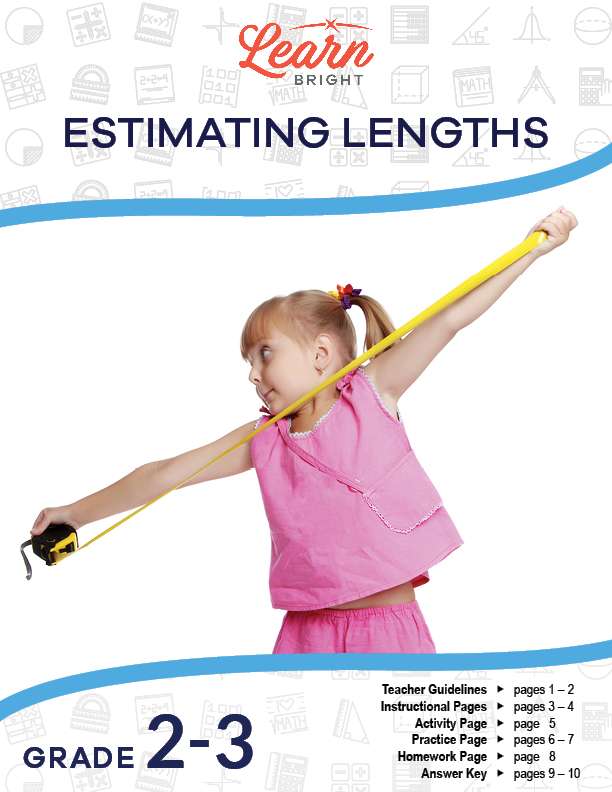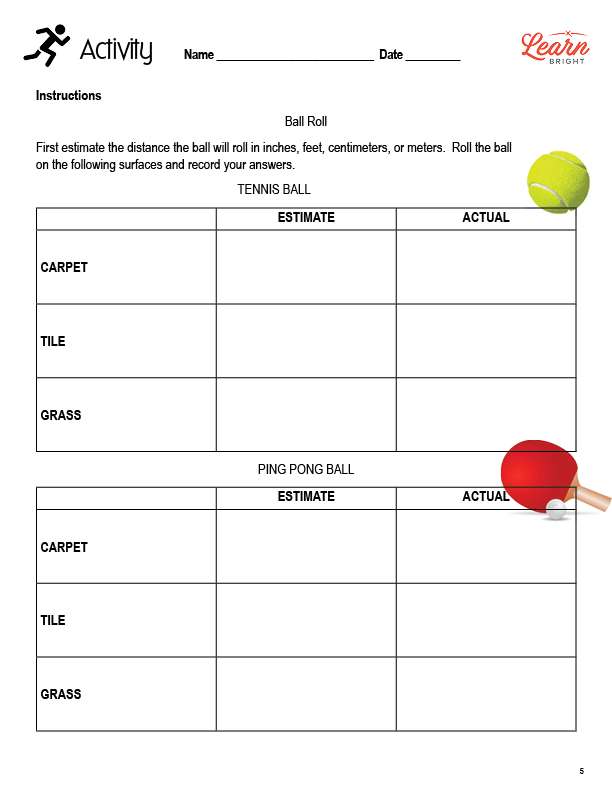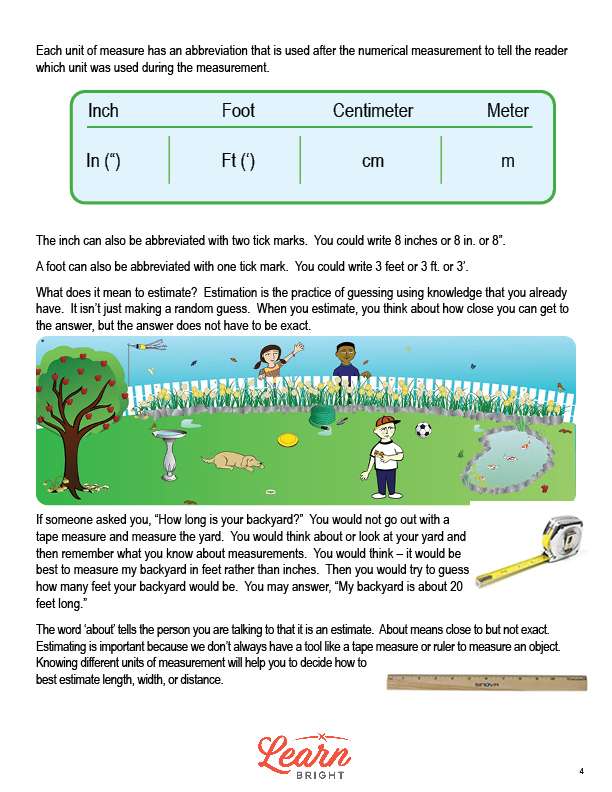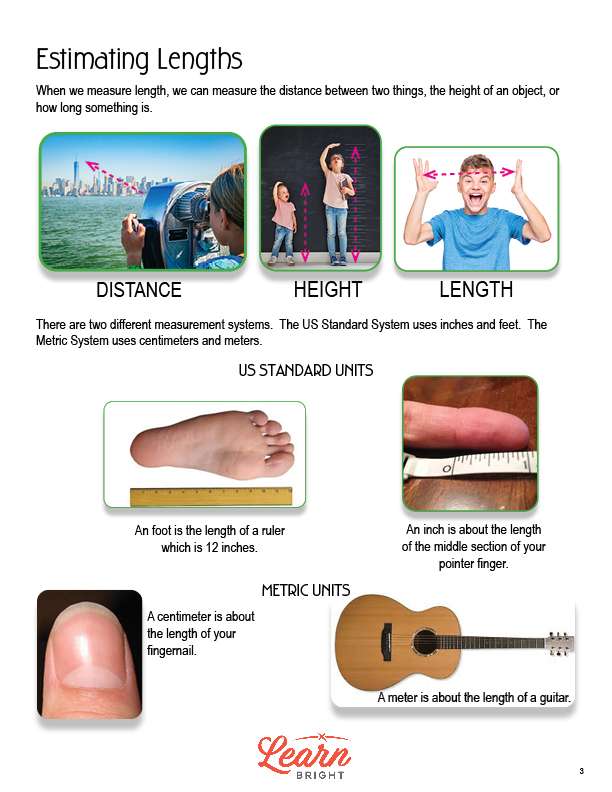Description
What our Estimating Lengths lesson plan includes
Lesson Objectives and Overview: Estimating Lengths teaches students the basics of estimating for length using different units of measurement. It also discusses the difference between length, height, and distance. At the end of the lesson, students will be able to estimate lengths using inches, feet, centimeters, and meters. This lesson is for students in 2nd grade and 3rd grade.
Classroom Procedure
Every lesson plan provides you with a classroom procedure page that outlines a step-by-step guide to follow. You do not have to follow the guide exactly. The guide helps you organize the lesson and details when to hand out worksheets. It also lists information in the blue box that you might find useful. You will find the lesson objectives, state standards, and number of class sessions the lesson should take to complete in this area. In addition, it describes the supplies you will need as well as what and how you need to prepare beforehand. The supplies that you will need for this lesson include tennis balls, ping pong balls, tape measures, and rulers.
Options for Lesson
Included with this lesson is an “Options for Lesson” section that lists a number of suggestions for activities to add to the lesson or substitutions for the ones already in the lesson. One optional addition to this lesson is to have your students use a map to determine distances between cities after they estimate the distance. If you have more advanced students, you can incorporate miles and yards into the lesson. For an additional activity, you could have your students estimate and measure items around the classroom or school. Finally, you could have your. students guess their height and then measure it in inches, feet, centimeters, and meters.
Teacher Notes
The teacher notes page includes lines that you can use to add your own notes as you’re preparing for this lesson.
ESTIMATING LENGTHS LESSON PLAN CONTENT PAGES
Estimating Lengths
The Estimating Lengths lesson plan includes two content pages. When measuring length, we can measure a few different things, like the distance between two object, the height of an object, or how long something is.
We have two main measurement systems in the world, the US Standard System and the Metric System. The US Standard System uses inches and feet, while the Metric System uses centimeters and meters.
For US Standard Units, we use feet (the length of a ruler, or 12 inches) and inches (about the length of the middle section of your pointer finger). For Metric Units, we use centimeters (about the length of your fingernail) and meters (about the length of a guitar). Each of these units has an abbreviation that we use after the numerical measurement: inches are in (of the symbol “), feet are ft (or the symbol ‘), centimeters are cm, and meters are m.
Estimating is when you use the knowledge that you already have, not just making a random guess. When estimating, you should try to get as close to the correct answer as possible without worrying about the estimation being exact.
For example, someone might ask you how long your backyard is. Instead of measuring your backyard with a measuring tape, you could look at your yard and think about what you know about measurements. You might realize that it’s better to measure your backyard in feet than in inches, and then make a guess. Your backyard might be about 20 feet long.
When you use the word “about” it signals to the person you’re talking to that your answer is an estimate. It’s close to the correct answer but is not exact. It’s important to be able to estimate because we don’t always have the tools or time to measure something. Knowing the differences between different measurements can help you decide how to estimate length, width, and distance.
ESTIMATING LENGTHS LESSON PLAN WORKSHEETS
The Estimating Lengths lesson plan includes four worksheets: an activity worksheet, a practice worksheet, a homework assignment, and a quiz. You can refer to the guide on the classroom procedure page to determine when to hand out each worksheet.
BALL ROLL ACTIVITY WORKSHEET
The activity worksheet asks students to first estimate the distance both a tennis ball and ping pong ball ball will roll in inches, feet, centimeters, or meters. They will then roll the balls on carpet, tile, and grass and record their answers.
LENGTH, DISTANCE, OR HEIGHT PRACTICE WORKSHEET
For the practice worksheet, students will estimate the length, distance, or height for each object shown.
ESTIMATING LENGTHS HOMEWORK ASSIGNMENT
The homework assignment asks students to find objects in their homes (a chair, a fridge, a couch, a fork, and a plate) and estimate the measurement of each. They will then find the actual measurement and write it down on the worksheet.
QUIZ
This lesson also includes a quiz that you can use to test students’ understanding of the lesson material. For the quiz, students will estimate the length, distance, or height for each object shown.
Worksheet Answer Keys
This lesson plan includes answer keys for the practice worksheet and the quiz. If you choose to administer the lesson pages to your students via PDF, you will need to save a new file that omits these pages. Otherwise, you can simply print out the applicable pages and keep these as reference for yourself when grading assignments.









